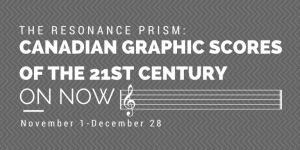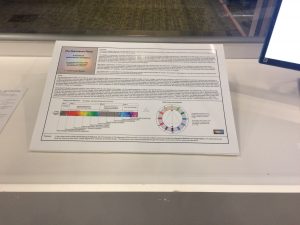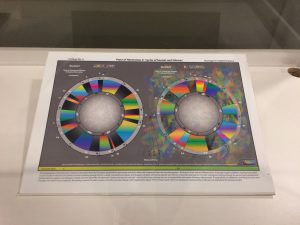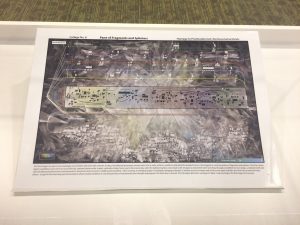
Canadian composer Howard Bashaw’s sound-art performance installation The Resonance Prism was premiered in 2014 in a concert event entitled Sound Space Architecture in the University of British Columbia’s Centre for Interactive Research on Sustainability. Performers were required to both realize the specific material presented in the score and generate imaginative, inspired improvisations. The chosen venue functioned metaphorically as a prismatic enclosure, refracting and transforming light into complex and layered dimensions of color, time and sound. With this work, Bashaw abandons the constraints of traditional music notation for innovative possibilities inherent within graphic notation and visual symbols. The viewer is invited to experience this collision between music and art and to imagine the translation of this graphic score into sound.

The Resonance Prism contains ten contrasting sequenced movements that are each separated in the form of a graphic collage, where the conductor combines and recombines a range of components during the performance through layering and evolving. Accompanying each collage is a visual statement that is projected during the performance and viewed simultaneously by the performers and the audience. These images facilitate the performance and evokes various sonic images in the minds of the audience, creating a dynamic engagement between the conductor, the audience, and the performers.

Artist’s Statement- Howard Bashaw
“Although not new, ‘sound, space and architecture’ certainly endures as an alluring compositional challenge. I began by imagining the atrium as an enormous prism; one that reflects natural light (metaphorically speaking) into new broad, successive regions: the first containing various manifestations of colour and harmony, and the second, various manifestations of rhythm and pattern. The score is designed specifically to inspire more so than to prescribe, and therefore takes form as ten full-colour, highly-detailed graphic collages. It uses specific pitch-color correlations throughout, and, in extension, incorporates the natural spectrum as the fundamental, organizing principle for the entire work. The ensemble is divided into three groups: the background source spectra (electronics); the middle-ground transitional spectra (percussion and electric guitar), and the foreground antiphonal spectra (three spatialized choirs: winds, brass and strings). The conductor functions as a dynamic collaborator, interpreting and shaping the wood anew with every performance.”
Graphic Scores
Bashaw shows how art and music are colliding in the 21st century with the use of musical notations in his graphic scores. Artists and musicians can now experiment with musical notations to create beautiful visual scores as modern works of art. This becomes a performance installation that provides a different experience to the audience than the traditional concert style performance.

American Musicological Society
The exhibition coordinates with the American Musicological Society‘s joint conference with Society for Music Theory held at the Sheraton Vancouver Wall Centre Hotel. The AMS was founded in 1934 as a non-profit organization to advance “research in the various fields of music as a branch of learning and scholarship”. In 1951, the Society became a member of the American Council of Learned Societies. Today, the society currently has 3,500 members and 1,000 institutional subscribers from forty different nations.
The American Musicological Society and the Society for Music theory bring together academics, graduate students and other professionals specializing in musicology and music theory. This joint conference marks the largest single gathering of participants in the field of music and humanities in the world this year. This conference marks the eightieth-second meeting for the AMS and thirty-ninth annual event for the SMT. The event will provide attendees an opportunity to a wider network, share knowledge, and explore new directions in music research and practice. The event has scheduled over 350 presentations, a number of large performances, small meetings, receptions, and other exciting events.
Register: Registration rates for regular members before October 28th are $135 and $75 for members who are students or retired. Non-member registration fees are $225 and $135 for non-members who are students or retired.
The exhibition will take place from Tuesday, November 1st to December 28th, 2016.